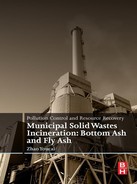Book Description
Pollution Control and Resource Recovery: Municipal Solid Wastes Incineration: Bottom Ash and Fly Ash explains the tools and technologies needed to characterize, stabilize, treat, recycle, or properly dispose bottom and fly ash.
The public concern for the environmental impact of MSW incineration has increased significantly over the last 20 years, forcing manufacturers to develop, and plants to install and operate, high-cost advanced technology for pollution control. This book explores the latest information on this important topic.
- Includes methods for characterization, stabilization, and solidification, treatment, and final disposal and recycling of bottom ash and fly ash
- Provides the characterization of bottom ash and fly ash, the impact of moisture on the incineration process of municipal solid waste, and the weathering process of bottom ash in a landfill
- Presents a brief, but rigorous, discussion of the constituents of fly and bottom ash, including polynuclear aromatic compounds and heavy metals
